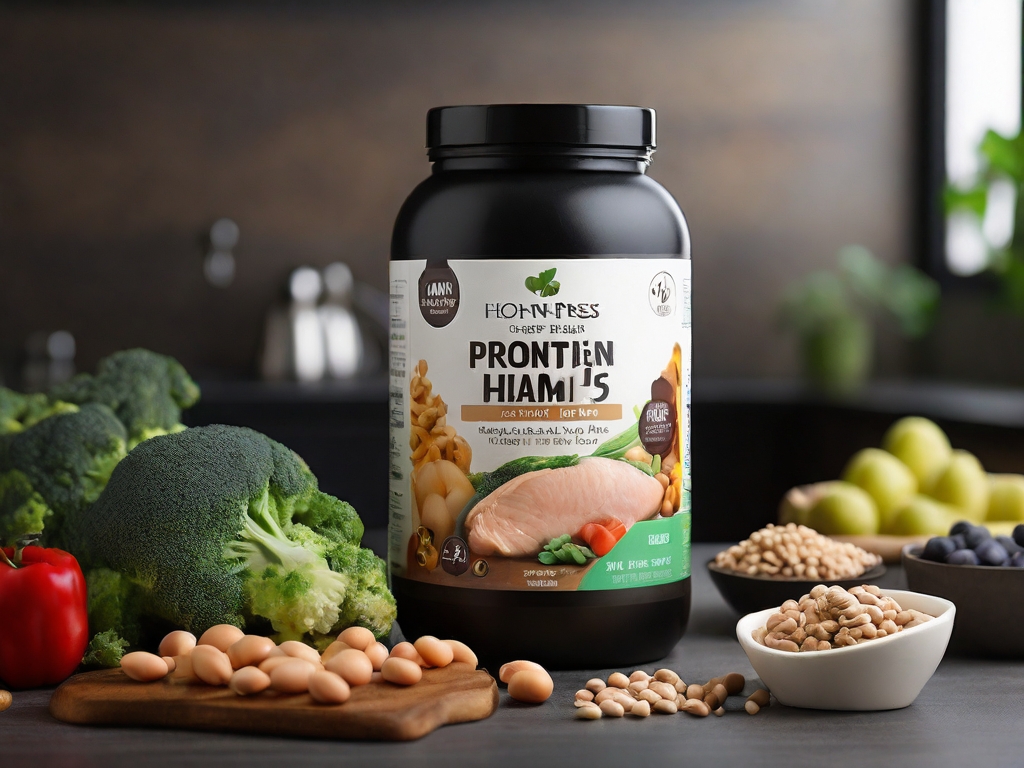A healthy low-carbohydrate diet is a dietary approach that focuses on reducing the intake of carbohydrates while increasing the consumption of proteins and healthy fats. The main goal of a low-carb diet is to limit the body’s reliance on carbohydrates as a source of energy and instead encourage it to burn stored fat for fuel. By reducing carb intake, the body enters a state called ketosis, where it produces ketones from fat breakdown. This metabolic shift has been associated with various health benefits, including weight loss, improved blood sugar control, and increased energy levels.
Table of Contents
ToggleBenefits of a healthy low-carbohydrate diet
Adopting a healthy low-carb diet can offer several benefits for your overall well-being. Firstly, it can aid in weight loss by reducing hunger pangs and promoting a feeling of fullness due to the higher consumption of protein and fat. Additionally, a low-carb diet can improve blood sugar control, making it an ideal choice for individuals with diabetes or insulin resistance. Studies have shown that this dietary approach can lower blood pressure and decrease triglyceride levels, both of which contribute to a reduced risk of heart disease. Furthermore, a low-carb diet has been found to enhance cognitive function and mental clarity, potentially benefiting individuals with neurodegenerative diseases such as Alzheimer’s.
How a low-carbohydrate diet works
A low-carb diet works by limiting the intake of carbohydrates, which are broken down into glucose and used as the primary source of energy in the body. When carbs are restricted, the body turns to alternative fuel sources, such as stored fat, and begins producing ketones. This metabolic state is called ketosis. By relying on fat for energy, the body can efficiently burn stored fat, leading to weight loss. Additionally, ketones have been shown to have neuroprotective effects, providing energy to the brain and improving cognitive function. While the transition to a low-carb diet may initially cause some discomfort, such as the “keto flu,” it is temporary and can be mitigated by staying hydrated and ensuring adequate electrolyte intake.
Common misconceptions about low-carb diets
Despite the popularity of low-carb diets, misconceptions abound. Not all carbs are bad; it’s vital to prioritize complex carbs from whole grains and veggies over simple ones from sugars. While a low-carbohydrate diet may mean higher protein, balance is key to avoiding kidney strain. Proper planning ensures a sustainable, healthy low-carb lifestyle.
Tips for starting a healthy low-carbohydrate diet
- Educate yourself: Before starting a low-carb diet, take the time to understand the principles behind it and familiarize yourself with the types of foods that are low in carbohydrates.
- Gradual reduction: Instead of drastically cutting out all carbs, gradually reduce your intake over time. This approach can help your body adjust and make the transition more sustainable.
- Focus on whole foods: Opt for natural, unprocessed foods that are low in carbohydrates, such as lean meats, fish, eggs, and vegetables, and healthy fats like avocado and olive oil.
- Stay hydrated: Drinking enough water is crucial during a low-carb diet, as it can help alleviate symptoms of the “keto flu” and support overall health.
Planning your low-carbohydrate diet plan
- Calculate your macronutrient needs: Determine your optimal intake of carbohydrates, proteins, and fats based on your goals, activity level, and personal preferences.
- Prioritize protein: Include a source of protein in each meal to promote satiety and support muscle maintenance. Good options include lean meats, poultry, fish, tofu, and legumes.
- Incorporate non-starchy vegetables: Fill your plate with an array of colorful vegetables, such as leafy greens, broccoli, cauliflower, zucchini, peppers, and mushrooms. These are low in carbs and rich in essential nutrients.
Low carb diet-friendly grocery shopping
- Shop the perimeter: The outer aisles of the grocery store typically contain fresh produce, meats, and dairy products, which are the foundation of a low-carb diet. Minimize your time in the processed food aisles.
- Read labels: Check food labels for hidden sugars, carbohydrates, and unhealthy additives. Avoid products that contain high-fructose corn syrup, artificial sweeteners, and trans fats.
- Choose whole grains wisely: If you opt for whole grains, look for products with minimal processing and high fiber content. Quinoa, brown rice, and whole wheat products can be consumed in moderation.
Easy and delicious low-carb recipes
- Grilled Chicken Caesar Salad: Marinate chicken breasts in a mixture of olive oil, lemon juice, garlic, and herbs. Grill until cooked through. Toss with romaine lettuce, Parmesan cheese, and a homemade low-carb Caesar dressing made with Greek yogurt.
- Baked Salmon with Roasted Vegetables: Place seasoned salmon fillets on a baking sheet and bake until flaky. Serve with a side of roasted Brussels sprouts, bell peppers, and asparagus drizzled with olive oil.
- Cauliflower Crust Pizza: Make a low-carb pizza crust using cauliflower rice, eggs, cheese, and spices. Top with tomato sauce, mozzarella cheese, and your favorite low-carb toppings like mushrooms, spinach, and grilled chicken.
- Zucchini Noodles with Pesto: Spiralize zucchini into noodles and sauté until tender. Toss with homemade pesto made from basil, garlic, pine nuts, Parmesan cheese, and olive oil. Add grilled shrimp or chicken for added protein.
- Low-Carb Chocolate Avocado Mousse: Blend ripe avocados, unsweetened cocoa powder, a natural sweetener like stevia or monk fruit, and a splash of almond milk until smooth and creamy. Chill in the refrigerator for a decadent, low-carb dessert.
Maintaining a healthy low-carb diet long-term
- Regularly revisit your goals: Assess your progress and adjust your goals as needed. This will keep you motivated and help prevent stagnation.
- Variety is key: Experiment with different low-carb recipes, ingredients, and cooking methods to keep your meals exciting and prevent boredom.
- Practice mindful eating: Pay attention to hunger and fullness cues, and eat until you are satisfied, not stuffed. Mindful eating can help you develop a healthier relationship with food.
- Plan ahead: Take time each week to plan your meals, create a shopping list, and prep ingredients in advance. This will make it easier to stick to your low-carb diet when life gets busy.
- Allow for flexibility: While staying consistent is important, it’s also essential to allow for occasional indulgences. Incorporating a treat or a higher-carb meal once in a while can help prevent feelings of deprivation and promote sustainability.
Also Read:- Low-Carbs Diet: Healthy Food Ideas and Cooking Recipes to Satisfy Your Palate
Low Carbohydrate Diet Meal Plan
Use our Low Carb Diet Meal Plan to start your path toward better health. Savor tasty, nutrient-dense meals that emphasize healthy fats and protein while reducing the amount of carbohydrates. This well designed plan guarantees fulfillment without letting your low-carb lifestyle slip.

3 DAYS LOW CARB MEAL PLAN
This is an example of a three-day low-carb menu. Having said that, find out from a physician or nutritionist what your ideal daily allowance of carbohydrates is based on your individual needs and health objectives.
Day 1
- Breakfast consists of half an avocado, two slices of sprouted Ezekiel bread (Trusted Source), salt, and pepper. 36.5 grams of carbohydrates total.
- Three ounces (oz; 85 g) for lunch two cups (340 g) of zucchini and grilled chicken Trusted Source Noodles from Trusted Source with just one garlic clove Butter, 1 oz (28 g) of Parmesan, and Trusted Source all contributed. 17 g of total carbohydrates.
- Dinner is a burger without buns. Reliable Source featuring a dollop of cheddar Serve the Trusted Source cheese with 2 tablespoons (35.7 g) of salsa and 1/2 cup (78 g) of steamed broccoli. 8.5 g of total carbohydrates.
- Day’s total carbohydrates: 62 g
Day 2
- Trusted Source provides 7 oz (200 g) of plain Greek yogurt for breakfast, 1/4 cup (37 g) blueberries, and 1 ounce (28.35 g) almonds, for a total of 19.4 g of carbohydrates.
- Lunch consists of a 3-oz (85 g) roast rib eye from Trusted Source, 1/2 cup (120 g) of mashed rutabaga, and 1 cup (129 g) of sautéed green beans. The total compound weight is 13.5 g.
- Dinner is a 3-ounce (85-gram) baked fish.1/2 cup (90 g) of cooked asparagus and 3/4 cup (85 g) of cauliflower rice—7.7 g of total carbohydrates- are provided by Trusted Source.
- The daily total of carbohydrates: 40.6 g
Day 3
- Breakfast: breakfast with two large fried eggs (trusted source), one tomato (trusted source), and 1 cup diced avocado Source. Total carbs: 19 g.
- Lunch: two cups (244 g) shrimp garden salads plus shrimp Trusted Source, spinach, eggs, tomato plants, and carrots, with two teaspoons (tbsp), or thirty milliliters (mL), of olive oil vinaigrette Trusted Source. Total carbs: 10.5 g.
- Dinner: 3 oz (85 g) broiled chicken trusted standard with 1/2 cup (78 g) browned French sprouts trusted stock and 1/2 cup (93 g) boiled quinoa Source—total carbs: 25.2 g.
- Total carbohydrates for the day: 54.7 g
Healthy low carb snacks
In case you find yourself feeling peckish in between meals, try these nutritious, simple-to-make, low-carb snacks:
- a fruit slice and Greek yogurt
- one or two eggs, hard-boiled
- a small handful of almonds and leftover tiny carrots from the previous evening
- A little pork and cheese
6 Low Carbohydrate High Protein Diet Plan
With our carefully designed low-glucose, high-protein diet plan, you may start a life-changing path towards optimal wellness. Discover the strength of lean proteins, such as chicken breast, which has about 31g of protein per 100g when combined with veggies that are high in nutrients and only 12g of carbohydrates. This plan, which is scientifically prepared, guarantees long-lasting energy, support for your muscles, and a tasty route to reaching your fitness objectives. Achieve optimal nutrition by consuming 30% carbohydrates, 40% protein, and 30% fats that are healthy.

1. Grilled Chicken Salad Bowl
Grilled chicken breast served over a bed of mixed greens, cherry tomatoes, cucumbers, and avocado. Drizzle with a light olive oil and lemon dressing for a satisfying and protein-packed meal.
2. Salmon and Asparagus Bake
Baked salmon fillets with a lemon and herb marinade, accompanied by roasted asparagus. This dish is rich in omega-3 fatty acids and provides a substantial protein boost while keeping carbs to a minimum.
3. Turkey and Veggie Stir-Fry
Lean ground turkey stir-fried with an array of colorful vegetables such as bell peppers, broccoli, and snap peas. Season with low-carb soy sauce or herbs for a flavorful, high-protein, and low-carb option.
4. Egg and Spinach Breakfast Wrap
Scrambled eggs combined with sautéed spinach, wrapped in a whole wheat or low-carb tortilla. This breakfast option is quick, easy, and provides a great balance of protein and healthy fats.
5. Cauliflower Fried Rice with Shrimp
Grated cauliflower sautéed with shrimp, peas, carrots, and scrambled eggs. A tasty alternative to traditional fried rice, this dish is low in carbs and high in protein, making it a perfect choice for a satisfying meal.
6. Greek Yogurt Parfait
Greek yogurt layered with berries, nuts, and a drizzle of honey. This low-carb, high-protein dessert or snack option offers a sweet treat while keeping added sugars in check.
Conclusion
A healthy low-carbohydrate diet can offer numerous benefits for weight loss, blood sugar control, and overall well-being. By reducing carb intake and focusing on whole foods rich in protein and healthy fats, you can achieve sustainable and long-lasting results. Remember to plan your meals, stock your pantry with low-carb essentials, and experiment with delicious recipes to keep your low-carb journey exciting and enjoyable. With the right mindset and strategies, you can successfully adopt a healthy low-carb lifestyle. Start today and experience the transformative power of a low-carb diet.
FAQS ABOUT LOW-CARBOHYDRATE DIET PLAN
Q: What is a low-carbohydrate diet?
A low-carbohydrate diet is an eating plan that restricts the intake of carbohydrates, emphasizing higher proportions of proteins and fats. This approach is often used for weight management and blood sugar control.
Q: How many carbs are considered low-carb?
The definition of low-carb can vary, but it typically involves consuming fewer than 20-50 grams of carbohydrates per day. Individual needs may vary based on factors such as age, activity level, and health goals.
Q: What are the main sources of protein in a low-carb diet?
Common protein sources in a low-carb diet include lean meats (chicken, turkey, beef), fish, eggs, tofu, and dairy products like Greek yogurt and cheese.
Q: Can I follow a low-carb diet as a vegetarian or vegan?
Yes, a low-carb diet can be adapted for vegetarian or vegan lifestyles by incorporating plant-based protein sources like tofu, tempeh, legumes, and a variety of vegetables with lower carbohydrate content.
Q: Are all carbohydrates eliminated on a low-carb diet?
No, not all carbohydrates are eliminated. The focus is on reducing intake of refined and high-glycemic carbohydrates, such as sugars and processed grains, while allowing for moderate consumption of nutrient-dense, fibrous carbs from vegetables and some fruits.
Q: Is a low-carb diet suitable for everyone?
While many people can benefit from a low-carb diet, it’s essential to consider individual health needs. Individuals with certain medical conditions, such as diabetes or kidney issues, should consult with a healthcare professional before making significant dietary changes.
Q: What are the potential benefits of a low-carb diet?
Benefits may include weight loss, improved blood sugar control, and enhanced satiety. Some people also experience increased energy levels and better concentration on a low-carb diet.
Q: Are there potential side effects of a low-carb diet?
Common side effects, often temporary, may include initial fatigue, known as the “low-carb flu,” and changes in bowel habits. It’s important to stay hydrated and ensure adequate intake of electrolytes.
Q: Can I exercise on a low-carb diet?
Yes, exercise can be part of a low-carb lifestyle. It may take some time for the body to adjust to using fat as a primary fuel source, but many individuals find they have sustained energy for workouts once adapted.
Q: Is a low-carb diet sustainable in the long term?
Long-term sustainability depends on individual preferences and adherence. Some people find success with a low-carb lifestyle, while others may prefer a more balanced approach. It’s crucial to find a dietary pattern that fits your lifestyle and goals.
Neha Pant







